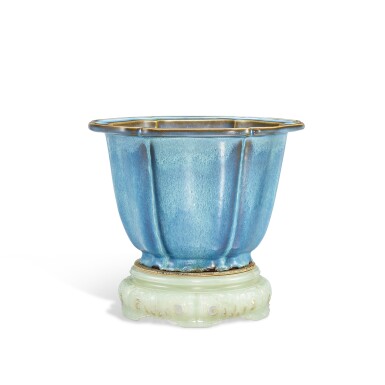Important Chinese Art
Important Chinese Art

Property from the Beixuan Shuzhai Collection | 柏煊書齋收藏
An important and exceptional Junyao flowerpot, Early Ming dynasty | 明初 鈞窰天藍釉葵花式花盆 「五」字款 連 清十八世紀 白玉鏤雕座
Premium Lot
Auction Closed
April 8, 02:15 PM GMT
Estimate
12,000,000 - 18,000,000 HKD
Lot Details
Description
Property from the Beixuan Shuzhai Collection
An important and exceptional Junyao flowerpot,
Early Ming dynasty
柏煊書齋收藏
明初 鈞窰天藍釉葵花式花盆 「五」字款 連 清十八世紀 白玉鏤雕座
the base inscribed with a numeral wu (five), with a Qing dynasty, 18th century white jade stand
w. 24.7 cm, h. 17.3 cm
T.Y. Chao Family Trust Collection, no. 98.
Sotheby’s London, 17th November 1999, lot 719.
趙從衍(1912-99年)家族基金收藏,編號98
倫敦蘇富比1999年11月17日,編號719
Qin Dashu, Junyao Ceramics from the Beixuan Shuzhai Collection, Hong Kong, 2017, pl. 29.
秦大樹,《柏煊書齋.鈞窰》,香港,2017年,圖版29
Unlike many other ceramics of the time, Jun ware pots like these were never exported or buried in tombs. Instead, they were actively used in the Ming and Qing court environments. This is evident in a scroll painting that depicts the Ming emperor Zhu Zhanji (1399-1435) enjoying the four seasons within the imperial palaces, where a pair of pots of almost identical colour and form is represented on the ground in front of the Emperor (Craig Clunas and Harrison-Hall, Ming: 50 Years that Changed China, London, 2014, pl. 85, pp. 97-99). The appreciation continued in the Qing Dynasty, as examples from the former Qing imperial collection were inscribed and assigned to palaces within the Forbidden City, the private residences of the famed imperial palace in Beijing. For example, a Jun pot inscribed Jianfugong (Palace of Established Happiness) horizontally and zhu shi jiashan yong (to be used for bamboo, rocks and fake mountains) vertically (Junci yaji / Selection of Jun ware, Beijing, 2013, pl. 68). In comparison, the base of this pot was grinded, leaving ‘T’ shaped marks, suggesting the pot had also been displayed in the Qing imperial palaces (Qin Dashu ed., Beixuan Shuzhai Junyao / Jun Yao Ceramics from the Beixuan Shuzhai Collection, Hong Kong, 2017, pl. 29).
The Jun ware pot inscribed with the numeral wu (five) is extremely rare. Surveying the public and private collections known today, only one similar example in the Palace Museum, Taipei (accession no. Gu ci 016537N000000000) has been published in Penping fenghua, Ming Qing huaqi tezhan / The Enchanting Splendor of Vases and Planters: A Special Exhibition of Flower Vessels from the Ming and Qing Dynasties, Taipei, 2014, cat. no. I-11.
The dating of Jun ware like this remains controversial. Some scholars believe that it was commissioned during the Northern Song period (960-1127), while others suggest that pots like these were commissioned by the Yongle (1403-24) and Xuande emperors (1426-35) of the Ming Dynasty (1368-1644). On the bases of these pots and on related basins (such as lot 3670), numbers from 1 to 10 are incised before glazing and firing, so they are often called "numbered Jun". The numbers seem to reflect their size, with 1 being the largest and 10 the smallest.
明初瓷器供外事或隨葬者不在少數,然鈞窰花盆非屬此類,乃明清宮廷常用。有卷軸描繪明宣宗朱瞻基(1399-1435年)四時行樂,圖中一對花盆,同形同色,置於宣宗身前地面(柯律格、霍吉淑,《明:盛世皇朝50年》,倫敦,2014年,圖版85,頁97-99)。而至清朝,鈞窰花盆仍受賞愛,清宮舊藏若干件,刻寫銘文,配予紫禁城內各宮各殿;如一鈞窰花盆,橫刻「建福宮」,豎刻「竹石假山用」(見《鈞瓷雅集》,北京,2013年,圖版68)。對比發現,此件鈞窰花盆底部經磨,有T形痕跡,可知此花盆亦曾為清宮所用(秦大樹(編),《柏煊書齋.鈞窰》,香港,2017年,圖版29)。
「五」字款鈞窰花盆極罕。遍尋當今公共及私人收藏,僅見一台北故宮例與此相類(藏品編號:故瓷016537N000000000),載於《瓶盆風華─明清花器特展》,台北,2014年,編號I-11。
此類鈞窰花盆斷代尚有爭議。有學者認為可溯至北宋(960-1127年),另有學者定為明代(1368-1644年),且出於永(1403-24年)、宣(1426-35年)二朝。此類花盆及相關水仙盆(如拍品編號3670)於施釉赴燒前刻數字於器底,由一至十,故而得名「數字鈞窰」。有數字反映尺寸之說,稱「一」字款最大,「十」字款最小
